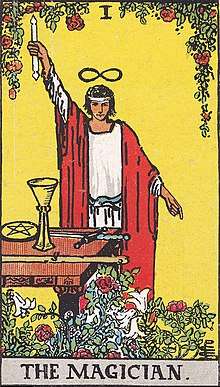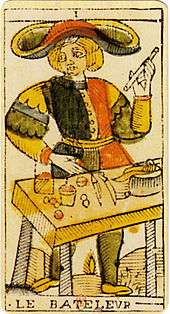The Magician (Tarot card)
The Magician (I), also known as The Magus or The Juggler, is the first trump or Major Arcana card in most traditional Tarot decks. It is used in game playing as well as in divination. In divination it is considered by some to succeed The Fool card, often numbered 0 (zero).

Iconography


In French Le Bateleur, "the mountebank" or the "sleight of hand artist", is a practitioner of stage magic. The Italian tradition calls him Il Bagatto or Il Bagatello. The Mantegna Tarocchi image that would seem to correspond with the Magician is labeled Artixano, the Artisan; he is the second lowest in the series, outranking only the Beggar. Visually the 18th-century woodcuts reflect earlier iconic representations, and can be compared to the free artistic renditions in the 15th-century hand-painted tarots made for the Visconti and Sforza families. In the painted cards attributed to Bonifacio Bembo, the Magician appears to be playing with cups and balls.[1]
In esoteric decks, occultists, starting with Oswald Wirth, turned Le Bateleur from a mountebank into a magus. The curves of the magician's hat brim in the Marseilles image are similar to the esoteric deck's mathematical sign of infinity. Similarly, other symbols were added. The essentials are that the magician has set up a temporary table outdoors, to display items that represent the suits of the Minor Arcana: Cups, Coins, Swords (as knives). The fourth, the baton (Clubs) he holds in his hand. The baton later stands for a literal magician's "wand".[2]
The illustration of the Tarot card "The Magician" from the Rider-Waite tarot deck was developed by A. E. Waite for the Hermetic Order of the Golden Dawn in 1910. Waite's magician features the infinity symbol over his head, and an ouroboros belt, both symbolizing eternity. The figure stands among a garden of flowers, to imply the manifestation and cultivation of desires.[3]
In the tarot game
In most tarot games, the Bagatto is the lowest ranking trump card but worth a lot of points. Therefore, many players want to take a trick when it is played. In most games played out of Italy, winning the last trick with it awards bonus points.
In tarocchini, the Bégato still serves as the lowest trump but it has an added ability. During score counting, it and the Fool can function as limited wild cards known as counters (contatori).[4] They can be used separately or together to fill missing gaps in combinations but they can't fill in two consecutive gaps in sequential combinations. They can't replace the highest trump or kings. Both cards can be used in every sequence but as the Fool can't be captured while the Magician is vulnerable, the player holding the Magician would want to use it only judiciously.[5]
In Sicilian tarocchi, the Bagatto is the second lowest trump, outranking an unnumbered trump called Miseria of no significance.[6]
Symbolism
In the Magician's right hand is a scroll raised toward heaven, the sky or the element æther, while his left hand is pointing to the earth. This iconographic gesture has multiple meanings, but is endemic to the Mysteries and symbolizes divine immanence, the ability of the magician to bridge the gap between heaven and earth. On the table in front of the Magician the symbols of the four Tarot suits signify the Classical elements of earth, air, fire and water. Beneath are roses and lilies, the flos campi and lilium convallium,[lower-alpha 1] changed into garden flowers, to show the culture of aspiration.[lower-alpha 2][7]
Divination
According to Lionnet, when the Magician appears in a spread, it points to the talents, capabilities and resources at the querent's disposal. Depending on the card's placement in relation to other cards, the message is to tap into one's full potential rather than holding back, especially when there is a need to transform something. There are choices and directions to take. Guidance can arrive through one's own intuition or in the form of someone who brings about change or transformation.[9]
According to A. E. Waite's Pictorial Key To The Tarot,[10] the Magician card is associated with:
Skill, diplomacy, address, subtlety, pain, loss, disaster, snares of enemies; self-confidence, will; [it signifies] the Querent, if male. Reversed: Physician, mental disease, disgrace, disquiet.
Waite writes that this card signifies the divine motive in man.[11]
In art
The Surrealist (Le surréaliste), 1947, is a painting by Victor Brauner. The Juggler provided Brauner with a key prototype for his self-portrait: the Surrealist's large hat, medieval costume, and the position of his arms all derive from this figure who, like Brauner's subject, stands behind a table displaying a knife, a goblet, and coins.[12]
Notes
- This is a reference to the Song of Songs, Chapter 2, verse 1 - ego flos campi et lilium convallium (I am a rose of Sharon, a lily of the valleys) s:Bible (World English)/Song of Solomon#Chapter 2
- Refer the Language of flowers.
Citations
- Bill Butler, Dictionary of the Tarot. (Schocken, 1975; ISBN 0-8052-0559-4)
- Butler, supra.
- Gray, E. (1960). The Tarot Revealed: A Modern Guide to Reading the Tarot Cards. New York, N.Y.: Bell Publishing Company.
- Tarocchino Bolognese
- Tarocchini sequences
- Sicilian tarocchi
- This article incorporates text from the public domain 1910 book Pictorial Key to the Tarot by Arthur Edward Waite. Please feel free to update the text.
- McCann, David (March 1999). Houlding, Deborah (ed.). "Mercury in Myth & Occult Philosophy". The Traditional Astrologer. Nottingham, UK: Ascella (18).
- Annie Lionnet, Secrets of Tarot, Dorling Kindersley (DK series) p 41
- Waite, Arthur Edward, 1857-1942. (2005). The pictorial key to the tarot (PDF). Mineola, NY: Dover Publications. ISBN 0-486-44255-1. OCLC 57549699.CS1 maint: multiple names: authors list (link)
- Arthur Edward Waite's: The Pictorial Key to the Tarot #I. The Magician
- Childs, Elizabeth C. "The Surrealist (Le surréaliste). January 1947 - Guggenheim Museum". Guggenheim.org. Retrieved 14 May 2013.
References
- A. E. Waite's 1910 Pictorial Key to the Tarot
- Most works of Joseph Campbell.
- Lewis Hyde, Trickster Makes this World: Mischief, Myth, and Art (1998).
- Juliette Wood, Folklore 109 (1998):15-24, The Celtic Tarot and the Secret Tradition: A Study in Modern Legend Making (1998)
External links

- Zeegee website